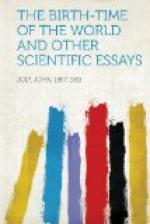72
hope to carry on aggregation of energy beyond the period when differences of potential are not. The organism is not accountable for this. It is being affected by events external to it, by the actions going on through inanimate agents. And although there be only a part of the received energy preserved, there is a part preserved, and this amount is continually on the increase. To see this it is only necessary to reflect that the sum of animate energy—capability of doing work in any way through animate means—at present upon the Earth, is the result, although a small one, of energy reaching the Earth since a remote period, and which otherwise had been dissipated in space. In inanimate actions throughout nature, as we know it, the availability is continually diminishing. The change is all the one way. As, however, the supply of available energy in the universe is (probably) limited in amount, we must look upon the two as simply effecting the final dissipation of potential in very different ways. The animate system is aggressive on the energy available to it, spends with economy, and invests at interest till death finally deprives it of all. It has heirs, indeed, who inherit some of its gains, but they, too, must die, and ultimately there will be no successors, and the greater part must melt away as if it had never been. The inanimate system responds to the forces imposed upon it by sluggish changes; of that which is thrust upon it, it squanders uselessly. The path of the energy is very different in the two cases.
73
While it is true generally that both systems ultimately result in the dissipation of energy to uniform potential, the organism can, as we have seen, under particular circumstances evade the final doom altogether. It can lay up a store of potential energy which may be permanent. Thus, so long as there is free oxygen in the universe, our coalfields might, at any time in the remote future, generate light and heat in the universal grave.
It is necessary to observe on the fundamental distinction between the growth of the protoplasm and the growth of the crystal. It is common to draw comparison between the two, and to point to metabolism as the chief distinction. But while this is the most obvious distinction the more fundamental one remains in the energy relations of the two with the environment.[1] The growth of the crystal is the result of loss of energy; that of the organism the result of gain of energy. The crystal represents a last position of stable equilibrium assumed by molecules upon a certain loss of kinetic energy, and the formation of the crystal by evaporation and concentration of a liquid does not, in its dynamic aspect, differ much from the precipitation of an amorphous sediment. The organism, on the other hand, represents a more or less unstable condition formed and maintained by inflow of energy; its formation, indeed, often attended with a loss of kinetic energy (fixation of carbon in plants), but, if so, accompanied by




